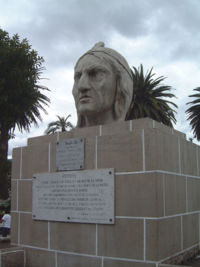
Rumiñahui (Inca warrior)
Encyclopedia

Atahualpa
Atahualpa, Atahuallpa, Atabalipa, or Atawallpa , was the last Sapa Inca or sovereign emperor of the Tahuantinsuyu, or the Inca Empire, prior to the Spanish conquest of Peru...
, led the resistance against the Spanish in the northern part of the Inca Empire (modern-day Ecuador) in 1533.
Born in Pillaro in the modern province of Tungurahua
Tungurahua
Tungurahua, , rahua : "Throat of Fire" or from Panzaleo) is an active stratovolcano located in the Cordillera Oriental of Ecuador. The volcano gives its name to the province of Tungurahua...
, Ecuador
Ecuador
Ecuador , officially the Republic of Ecuador is a representative democratic republic in South America, bordered by Colombia on the north, Peru on the east and south, and by the Pacific Ocean to the west. It is one of only two countries in South America, along with Chile, that do not have a border...
, his given name was Ati II Pillahuaso. Inca historians tend to believe that he was Atahualpa's half brother, born from a native noble woman. When Francisco Pizarro
Francisco Pizarro
Francisco Pizarro González, Marquess was a Spanish conquistador, conqueror of the Incan Empire, and founder of Lima, the modern-day capital of the Republic of Peru.-Early life:...
imprisoned Atahualpa and held him in the Ransom Room
Ransom Room
The Ransom Room is a small room located in Cajamarca, Peru. It is considered by most Peruvian historians to be the place where the Inca Empire came to an end with the capture and eventual execution of the Inca Emperor Atahualpa.When Francisco Pizarro arrived in Cajamarca on November 15, 1532, he...
, Rumiñahui marched towards Cajamarca
Cajamarca
Cajamarca may refer to:Colombia*Cajamarca, Tolima a town and municipality in Tolima DepartmentPeru* Cajamarca, city in Peru.* Cajamarca District, district in the Cajamarca province.* Cajamarca Province, province in the Cajamarca region....
to deliver a huge amount of gold. But when the Spaniards broke their word, executing Atahualpa and slaughtering his troops, Rumiñahui returned to the kingdoms of Quito and is believed to have ordered the Treasure of the Llanganatis
Treasure of the llanganatis
The Treasure of the Llanganatis refers to a huge sum of worked gold and other treasures supposedly hidden deep within the Llanganatis mountain range of Ecuador by the Inca general Rumiñahui....
thrown off a cliff into a lake or crater.
Learning of Rumiñahui's resistance, Pizarro sent his lieutenant Sebastián de Benalcázar North to take Quito
Quito
San Francisco de Quito, most often called Quito , is the capital city of Ecuador in northwestern South America. It is located in north-central Ecuador in the Guayllabamba river basin, on the eastern slopes of Pichincha, an active stratovolcano in the Andes mountains...
and bring whatever treasure he could recover. The forces of Rumiñahui and Benalcázar met at the Battle of Mount Chimborazo
Battle of Mount Chimborazo
-Prelude:Francisco Pizarro had toppled the Inca Empire, captured its Emperor Atahualpa and demanded a room of gold and two rooms with silver, he got the treasure but still executed Atahualpa...
, where Rumiñahui was defeated. However, before the Spanish forces captured Quito, Rumiñahui ordered it burned to the ground, and the Ñusties (temple virgins) killed to preserve their honor. Rumiñahui was eventually captured, tortured and killed by the Spanish but never revealed the location of the treasure.
"Rumiñahui" is a nickname. In Kichwa
Kichwa
Kichwa is a Quechuan language, and includes all Quechua varieties spoken in Ecuador and Colombia by approximately 2,500,000 people...
in means "eye of stone," interpreted by some to reference his firm stance against the Spanish at the Battle of Mount Chimborazo.
Legacy
In 1985 the Ecuadorian Congress made December 1 of every year a day of remembrance for the personality of Rumiñahui as an indigenous hero and defender of the Kingdom of Quito.Rumiñahui's portrait was the prominent image on the front of the 1,000 Ecuadorian sucre
Ecuadorian sucre
The sucre was the currency of Ecuador between 1884 and 2000. Its ISO code was ECS and it was subdivided into 10 decimos or 100 centavos. The sucre was named after Antonio José de Sucre.-History:...
note.

